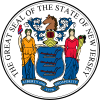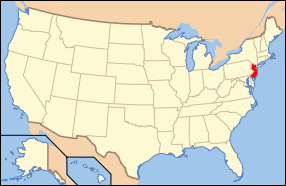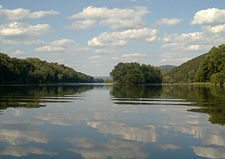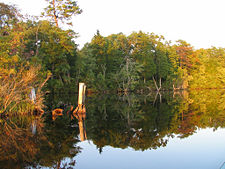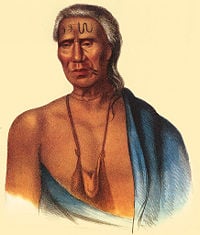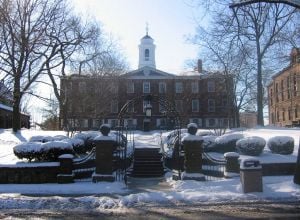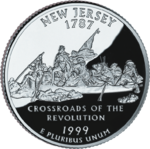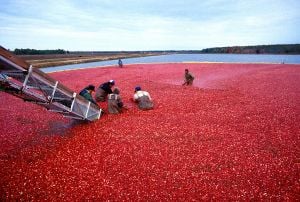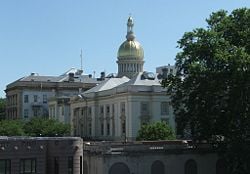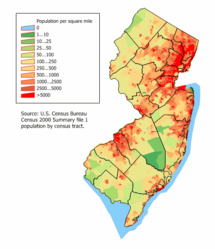New Jersey
| State of New Jersey | |||||||||||
| |||||||||||
| Official language(s) | None | ||||||||||
| Capital | Trenton | ||||||||||
| Largest city | Newark | ||||||||||
| Area | Ranked 47th | ||||||||||
| - Total | 8,721 sq mi (22,608 km²) | ||||||||||
| - Width | 70 miles (112 km) | ||||||||||
| - Length | 170 miles (273 km) | ||||||||||
| - % water | 14.9 | ||||||||||
| - Latitude | 38° 56′ N to 41° 21′ N | ||||||||||
| - Longitude | 73° 54′ W to 75° 34′ W | ||||||||||
| Population | Ranked 11th in the U.S. | ||||||||||
| - Total | 8,821,155 (2011 est)[2] | ||||||||||
| - Density | 1189/sq mi (459/km2) Ranked 1st in the U.S. | ||||||||||
| - Median income | $70,378 (2nd) | ||||||||||
| Elevation | |||||||||||
| - Highest point | High Point[3][4] 1,803 ft (549.6 m) | ||||||||||
| - Mean | 250 ft (80 m) | ||||||||||
| - Lowest point | Atlantic Ocean[3] 0 ft (0 m) | ||||||||||
| Admission to Union | December 18, 1787 (3rd) | ||||||||||
| Governor | Phil Murphy (D) | ||||||||||
| Lieutenant Governor | Sheila Oliver (D) | ||||||||||
| U.S. Senators | Cory Booker (D) Bob Menendez (D) | ||||||||||
| Time zone | Eastern: UTC-5/-4 | ||||||||||
| Abbreviations | NJ N.J. US-NJ | ||||||||||
| Web site | www.nj.gov | ||||||||||
New Jersey is one of the Mid-Atlantic states located in the Northeastern region of the United States of America. During North America's colonial era, New Jersey became known as a colony that tolerated religious diversity. New Jersey continues to be one of the most religiously and ethnically diverse states in the United States.
During the American Revolutionary War, British and American armies seeking to control the two important cities of New York and Philadelphia crossed New Jersey numerous times. Several pivotal battles took place across the state. Because of this, New Jersey is referred to as "The Crossroads of the Revolution."
Working-class cities such as Paterson and the state capitol Trenton helped drive the nineteenth century Industrial Revolution. New Jersey's position at the center of the megalopolis, between Boston, New York City, Philadelphia, Baltimore, and Washington, D.C. fueled its rapid growth through the suburban boom of the 1950s and beyond.
In the early twenty-first century, New Jersey was the eleventh-most populous of the 50 states, and is the most densely populated with 1,174 residents per square mile. It is the only state that has had every one of its counties deemed "urban" as defined by the United States Census Bureau. Despite this, New Jersey retains its nickname from more agrarian times, "The Garden State." New Jersey's greatest natural resource is its location, which has made the state a crossroads of commerce and an ideal area for manufacturing. Its factories and proximity to major ports draw many immigrants. Its miles of beaches draw hundreds of thousands of visitors annually, and tourism has become a major revenue source in the state. Socially, New Jersey is considered one of the most liberal states of the United States.
Geography
New Jersey is bordered on the north and northeast by New York; on the east by the Atlantic Ocean; on the south and southwest by Delaware across Delaware Bay; and on the west by Pennsylvania across the Delaware River. Most of the state consists of a coastal plain, rising to a plateau and then in the northwest to the Kittatinny Mountains, part of the Appalachian chain. A series of waterfalls formed where the rivers drop from the plateau to the plain are called the Fall Line.
Major rivers include the Manasquan, Maurice, Mullica, Passaic, Hackensack, Rahway, Rancocas, Raritan, Musconetcong, Toms, and Delaware rivers. The Palisades are a line of steep cliffs on the lower west side of the Hudson River.
North Jersey lies within New York City's general sphere of influence, and many residents commute to the city to work. Central Jersey is a largely suburban area. Southern Jersey is within Philadelphia's sphere of influence.
Sandy Hook, a popular recreational beach along the eastern coast, is a barrier spit and an extension of the Barnegat Peninsula along the Atlantic coast.
Prominent geographic features include:
- Delaware Water Gap
- Great Swamp National Wildlife Refuge
- The Highlands
- New Jersey Meadowlands
- Pine Barrens
- South Mountain
Climate
New Jersey has a humid continental climate, vastly affected by its proximity to the Atlantic Ocean. Winter is typically cold. The lows usually hover in the 10s and 20s°F (down to -10 °C) and can frequently dip below 0°F in the northwestern sections of the state. However, winter may be mild and almost snowless in sections of South Jersey near the Atlantic coastline.
Springs are mild, though thunderstorms are common. Summers tend to be hot and humid, with temperatures often exceeding 90°F (32°C). Hurricanes are considered to be a major threat to the area, especially the shore communities. While relatively infrequent compared to areas south and east, a direct hit could cause large loss of life and billions of dollars in damage due to the high population in the coastal areas. Autumns are comfortable though unpredictable. Temperatures may vary greatly from the northernmost to the southernmost parts of New Jersey.
Flora and fauna
Despite being densely populated in urban areas, about 42 percent of New Jersey is covered by forests. Maple, birch, and yellow poplar grow in the north, while cedars, dwarf oaks, and pines prevail in the southern part. New Jersey has more than 50 state parks and forests, from High Point State Park in the northwest corner to the Pine Barrens in the southeast, which are home to the carnivorous sundew. Deer, foxes, mink, and snakes can be found in the forests.
Along the coast, herons, ducks, and geese populate the marshes and clams, crabs, oysters, and lobsters live offshore. Fish are plentiful in the state's rivers and the ocean.
History
Around 18,000 years ago, the Ice Age resulted in glaciers that reached New Jersey. As the glaciers retreated, they left behind Lake Passaic, as well as many rivers, swamps, and gorges.[5]
New Jersey was originally settled by Native Americans, primarily the Lenni-Lenape. The Lenape were loosely organized groups that practiced small-scale agriculture (mainly based on corn) to increase their largely mobile hunter-gatherer society in the region surrounding the Delaware River, the lower Hudson River, and western Long Island Sound. The Lenape first encountered the Dutch in the early 1600s, and their primary relationship with Europeans was through the fur trade.
The first European settlements in the area were established by the Dutch, in the early 1600s. Henry Hudson's 1609, efforts to find a passage to Asia proved unsuccessful but established a basis for Dutch claims to the region. In 1664, the British seized control.
Colonial era
Since the state's inception, New Jersey has been characterized by ethnic and religious diversity. In eastern Jersey, New England Congregationalists settled alongside Scottish Presbyterians and Dutch Reformed migrants from New York. While the majority of residents lived in towns with individual landholdings of 100 acres, a few rich proprietors owned vast estates. Western Jersey had fewer people, and both English Quakers and Anglicans owned large landholdings. Both regions remained agrarian and rural throughout the colonial era, and commercial farming only developed sporadically. Some townships, though, like Burlington and Perth Amboy, emerged as important ports for shipping to New York and Philadelphia. The colony's fertile lands and tolerant religious policy drew more settlers, and New Jersey boasted a population of 120,000 by 1775.
Much of New Jersey was originally claimed by the Dutch. The Dutch colony of New Netherland consisted of parts of modern New York (New Amsterdam) and New Jersey. Although the European principle of land ownership was not recognized by the Lenape, Dutch policy required formal purchase of all land settled upon. The entire region became a territory of England in 1664, when an English fleet sailed into what is today New York Harbor and took over the colony with little resistance.
After Charles II of England was proclaimed king in 1649, following the execution of his father, Charles I, he gave his brother, the Duke of York (later King James II) the region between New England and Maryland as a proprietary colony (as opposed to a royal colony). James then granted the land between the Hudson River and the Delaware River (the land that would become New Jersey) to two friends who had remained loyal through the English Civil War: Sir George Carteret and Lord Berkeley of Stratton.
Settlement for the first 10 years of English rule was in the Hudson River region and came primarily from New England. On March 18, 1673, Berkeley sold his half of the colony to Quakers in England (with William Penn acting as trustee for a time), who settled the Delaware Valley region as a Quaker colony. New Jersey was governed as two distinct provinces, West Jersey and East Jersey, for the 28 years between 1674 and 1702. In 1702, the two provinces were united under a royal, rather than a proprietary, governor.
Revolutionary War era
New Jersey was one of the thirteen colonies that revolted against British rule in the American Revolution. The New Jersey Constitution of 1776 was passed July 2, 1776, just two days before the Second Continental Congress declared American Independence from Britain.
During the American Revolutionary War, British and American armies crossed New Jersey numerous times and several pivotal battles took place in the state. Because of this, New Jersey today is often referred to as "The Crossroads of the Revolution."
On Christmas Day, 1776, the Continental Army under George Washington crossed the Delaware River and engaged the unprepared Hessian troops in the Battle of Trenton. Slightly more than a week after victory at Trenton, on January 3, 1777, the American forces gained an important victory by stopping General Charles Cornwallis's charges at the Second Battle of Trenton. By evading Cornwallis's army, Washington made a surprise attack on Princeton, and successfully defeated the British forces there.
Later, American forces under Washington met the forces under General Henry Clinton at the Battle of Monmouth in an indecisive engagement. Washington attempted to take the British column by surprise; when the British army attempted to flank the Americans, the Americans retreated in disorder. The ranks were later reorganized and withstood the British charges.
In the summer of 1783, the Continental Congress met in Nassau Hall at Princeton University, making Princeton the nation's capital for four months. It was there that the Continental Congress learned of the signing of the Treaty of Paris (1783), which ended the war.
New Jersey was the third state to ratify the United States Constitution, which was overwhelmingly popular in New Jersey, as it prevented New York and Pennsylvania from charging and keeping tariffs on goods imported from Europe. In November 20, 1789, the state became the first in the newly formed Union to ratify the Bill of Rights.
The 1776 New Jersey State Constitution gave the vote to "all inhabitants" who had a certain level of wealth. This included both women and blacks; although not married women, who could not own property.
Nineteenth century
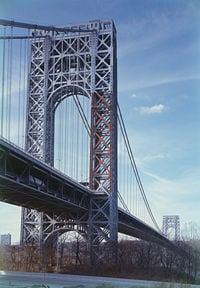
On February 15, 1804, New Jersey became the last northern state to abolish slavery by enacting legislation that slowly phased it out. By the close of the Civil War, however, about a dozen African-Americans in New Jersey were still apprenticed freedmen. New Jersey initially refused to ratify the constitutional amendments banning slavery and granting rights to America's black population.
Unlike the Revolutionary War, no Civil War battles took place within the state. However, throughout the course of the Civil War, over 80,000 enlisted in the Northern army to defeat the Southern rebels.
In the Industrial Revolution, cities like Paterson grew and prospered. Previously, the economy had been largely agrarian and thus was affected by crop failures and poor soil. This caused a shift to a more industrialized economy, one based on manufactured commodities such as textiles and silk. Inventor Thomas Edison also became an important figure, having been granted 1,093 patents. Transportation greatly improved as locomotion and steamboats were introduced to New Jersey.
Iron mining was also a prevalent industry during the middle to late 1800s. Mines created a thriving industry, which spawned new towns and was one of the driving forces behind the need for the Morris Canal.
Twentieth century
Through both World Wars, New Jersey was a center for war production, especially in naval construction. Battleships, cruisers, and destroyers were all made in the state. In addition, Camp Kilmer, Fort Dix (originally called "Camp Dix"), and Camp Merritt were all constructed to help American soldiers through both World Wars. New Jersey also became a principal location for defense in the Cold War. Fourteen Nike Missile stations were constructed, especially for the defense of New York City and Philadelphia, Pennsylvania. PT-109, commanded by Lt.(jg) John F. Kennedy, was built at the Elco Boatworks in Bayonne, and the aircraft carrier USS ''Enterprise'' (CV-6) was briefly docked at the Military Ocean Terminal in Bayonne in the 1950s before she was sent to Japan to be scrapped. In 1962, the world's first nuclear powered cargo ship, the NS ''Savannah'' was launched at Camden.
New Jersey became a prosperous state through the Roaring Twenties but fell from prosperity during the Great Depression.
In the 1960s, several race riots sprang up in New Jersey, the first of which occurred in Jersey City on August 2, 1964. Several other riots ensued in 1967, in the cities of Newark and Plainfield. Camden also dealt with race riots in 1971.
Economy
The Bureau of Economic Analysis estimates that New Jersey's total state product in 2004 was $416 billion.[6] Its per capita personal income in 2004 was $41,636, 2nd in the U.S. and 126 percent of the national average of $33,041.[7] Its median household income is the highest in the nation at $55,146. It is ranked second in the nation by the number of places with per capita incomes above national average with 76.4 percent. Nine of New Jersey's counties are in the wealthiest 100 of the country.
Natural resources
New Jersey's greatest natural resource is its location, which has made the state a crossroads of commerce and an ideal area for manufacturing. Other commercial advantages include its extensive transportation system, which puts one-quarter of all United States consumers within overnight delivery range. Lake and seaside resorts have contributed to New Jersey's rank of fifth among the states in revenues from tourism.
Despite more than three centuries of development, almost half of New Jersey is still wooded. The chief tree of the northern forests is the oak. A large part of the southern section is in pine. Jersey oak has been used extensively in shipbuilding.
The mineral resources in New Jersey are small. The state, however, does rank high in smelting and refining minerals from other states.
Industry
The Port Newark-Elizabeth Marine Terminal was the world's first container port and is one of the world's largest container ports. Newark Liberty International Airport is ranked seventh among the nation's busiest airports and among the top 20 busiest airports in the world.
The state's agricultural outputs are nursery stock, horses, vegetables, fruits and nuts, seafood, and dairy products. In particular, cranberries, peaches, tomatoes, and eggplants are some of the state's largest crops. Hammonton, in the southern part of the state, is known as the blueberry capital of the world.
Its industrial outputs are pharmaceutical and chemical products, food processing, electric equipment, printing and publishing, and tourism. New Jersey's economy has a large base of heavy industry and chemical manufacturing. Additionally, the state is home to the largest petroleum containment system outside of the Middle East.
New Jersey hosts several business headquarters, including twenty-four Fortune 500 companies.[8] While home to many chemical plants, New Jersey also is home to major pharmaceutical firms Merck, Wyeth, Johnson and Johnson, sanofi-aventis, Novartis, Pfizer, Hoffman-LaRoche, Bristol-Myers Squibb, and Schering-Plough. It draws upon its large and well-educated labor pool, which also supports the myriad industries that exist today.
Law and government
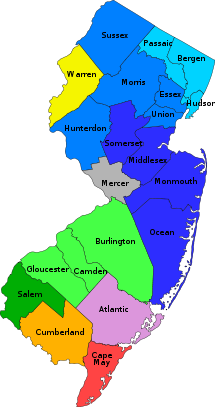
Trenton is the capital of New Jersey and the county seat of Mercer County. As of 2007, the United States Census Bureau estimated that the city had a population of 82,804.
The first settlement which would become Trenton was established by Quakers in 1679, in the region then called the Falls of the Delaware, led by Mahlon Stacy from Sheffield, United Kingdom. By 1719, the town adopted the name "Trent-towne," after William Trent, one of its leading landholders who purchased much of the surrounding land from Stacy's family. This name later was shortened to "Trenton." Trenton became New Jersey's capital as of November 25, 1790, and the City of Trenton was formed within Trenton Township on November 13, 1792.
Executive
The governor of New Jersey is considered one of the most powerful governorships in the nation, as it is the only state-wide elected office in the state and appoints many government officials.
New Jersey is one of the few states that has no Lieutenant Governor. The first Lieutenant Governor of New Jersey will take office in January 2010, and will be elected conjointly with the Governor of New Jersey. The position was created as the result of a constitutional amendment to the New Jersey State Constitution passed by the voters on November 8, 2005, and effective as of January 17, 2006.
Legislative
The current version of the New Jersey State Constitution was adopted in 1947. It provides for a bicameral New Jersey Legislature, consisting of an upper house Senate of 40 members and a lower house General Assembly of 80 members. Each of the 40 legislative districts elects one state senator and two Assembly members. Assembly members are elected for a two-year term in odd-numbered years; state senators are elected in the years ending in 1, 3, and 7 and thus serve either four- or two-year terms.
New Jersey is one of only five states that elects its state officials in odd numbered years (The others are Kentucky, Louisiana, Mississippi, and Virginia). New Jersey holds elections for these offices every four years in the years following federal presidential election years.
Counties
New Jersey is broken up into 21 counties, 13 of which date from the colonial era. New Jersey was completely divided into counties by 1692; the present counties were created by dividing the existing ones.
Politics
Political parties
New Jersey was once a politically competitive state in past federal elections but has become a Democratic stronghold since the 1980s. In state elections, offices remain competitive; the New Jersey Legislature was evenly divided from 1999 to 2001. In 2008, New Jersey Democrats held the Governorship, had majority control of both houses of the Legislature (Senate: 22-18 & Assembly: 49-31), while federal Democrats held both U.S. Senate seats and also 7 out of 13 of the state's delegation to the United States House of Representatives. Republicans have not won a statewide election since 1997. With the exception of then-Vice President George H. W. Bush's 1988 presidential victory, no Republican has received a majority of the vote in a statewide election since 1985, though the state had a Republican governor from 1994 to 2002, as Christine Todd Whitman won twice with vote percentages of 47 and 49 percent.
In federal elections, the state leans heavily toward the national Democratic Party. It was, however, a Republican stronghold for years in the past, having given comfortable margins of victory to the Republican candidate in the close elections of 1948, 1968, and 1976. New Jersey was a crucial swing state in the elections of 1960, 1968, and 1992.
Demographics
State population
The United States Census Bureau, as of July 1, 2006, estimated New Jersey's population at 8,724,560,[9] which represents an increase of 310,213, or 3.7 percent, since the prior census in 2000.[10] This includes a natural increase since the last census of 254,766 people (that is 705,812 births minus 451,046 deaths) and an increase due to net migration of 79,211 people into the state. Immigration from outside the United States resulted in a net increase of 357,111 people, and migration within the country produced a net loss of 277,900 people. There were 1.6 million foreign-born living in the state in 2005, accounting for 19.2 population of the population.[11]
As of 2006, New Jersey was the eleventh-most populous state, but the most densely populated, at 1,174 residents per square mile (453 per km²), although the density varied widely across the state. It was also the second wealthiest state per capita in the United States (behind only Connecticut) as per the United States Census Bureau.[12]
Race, ethnicity, and ancestry
New Jersey is one of the most religiously and ethnically diverse states in the country. It has the second largest Jewish population by percentage after New York;[13] the second largest Muslim population by percent (after Michigan); the third highest Asian population by percent, the fourth highest Italian-American population by percent of any state according to the 2000 census; and a large percentage of the population is African-American, White American, Hispanic American, Arab American, and Asian American. It has the second highest Indian American population of any state by absolute numbers.[14][15][16][17]
The five largest ancestry groups are: Italian (17.9 percent), Irish (15.9 percent), African (13.6 percent), German (12.6 percent), Polish (6.9 percent).
Newark and Camden are two of the poorest cities in America, but New Jersey as a whole has the highest median household income among the states. This is largely because so much of New Jersey consists of suburbs, most of them affluent, of New York City and Philadelphia. New Jersey is also the most densely populated state in the nation and is the only state that has had every one of its counties deemed "urban" as defined by the Census Bureau's Combined Statistical Area.[18]
Although the vast majority of the people living in the state are white and American-born, it has very sizable enclaves of different language speaking communities. Some of these include (by ranking)
- Spanish—spoken in many of the Hudson County towns, especially Union City.
- Portuguese—spoken throughout the entire state, but Brazilian Portuguese is common in Newark.
- Italian—spoken throughout the state also, but concentrated in Hudson and Essex counties.
The dominant race, ethnicity, or ancestry by county, according to the 2000 census, are the following:
- Italian—Bergen, Morris, Somerset, Ocean, Monmouth, Mercer, Middlesex, Union, Passaic, Hudson, Atlantic, Cumberland
- Irish—Sussex, Burlington, Camden, Gloucester, Cape May
- Black—Essex
- German—Warren, Hunterdon, Salem[17]
Social attitudes and issues
Socially, New Jersey is considered one of the most liberal states in the nation. Polls indicate that two-thirds of the population are self-described as pro-choice;[19] and in a Zogby poll of 803 people, a majority supported same-sex marriage.[20]
In April 2004, New Jersey enacted a domestic partnership law, which is available to both same-sex and opposite-sex couples aged 62 and over. Moreover, effective February 19, 2007, New Jersey became the third state (the other two being Connecticut and Vermont) to offer civil unions to same-sex couples, conferring over 850 rights, privileges, and responsibilities of marriage; legislators declined, however, to use the term "marriage" for same-sex unions. Thus, three separate government-recognized relationships are now in effect in the Garden State: Domestic partnerships, civil unions, and marriage.
New Jersey also has some of the most stringent gun-control laws in the U.S. These include bans on assault firearms, hollow nose bullets, and even slingshots. No gun offense in New Jersey is graded less than a felony. BB guns and black powder guns are all treated as modern firearms. New Jersey recognizes no out-of-state gun licenses and aggressively enforces its own gun laws.[21]
New Jersey is still plagued by organized crime, though a number of its key Mafia figures are serving prison time. In May 2008, 23 people—all members or associates of various Mafia factions—were indicted for crimes including illegal gambling rings, labor racketeering, and extortion. However, experts say the Mafia's role is being undercut by organized crime gangs from Europe, Latin America, and Asia that may not be as organized but whose techniques are more sophisticated. [22]
Notes
- ↑ The Garden State and Other New Jersey State Nicknames, Robert Lupp, New Jersey Reference Services, New Jersey State Library, October 12, 1994. Retrieved February 15, 2012.
- ↑ Error on call to template:cite web: Parameters url and title must be specified (CSV). 2011 Population Estimates. United States Census Bureau, Population Division (December 2011).
- ↑ 3.0 3.1 Elevations and Distances in the United States. United States Geological Survey (2001). Retrieved October 24, 2011.
- ↑ Elevation adjusted to North American Vertical Datum of 1988.
- ↑ Great Swamp Watershed Association, Geological History. Retrieved October 5, 2008.
- ↑ Bureau of Economic Analysis, Widespread Gross State Product (GSP) Growth in 2004 Led by Services-Providing Industries. Retrieved October 5, 2008.
- ↑ Bureau of Economic Analysis, Regional Economic Accounts. Retrieved October 5, 2008.
- ↑ CNN Money.com, March 30, 2007, Fortune 500 2007—States: New Jersey. Retrieved October 5, 2008.
- ↑ U.S. Census Bureau, 2006 Population Estimates. Retrieved October 7, 2008.
- ↑ U.S. Census Bureau, Cumulative Estimates of the Components of Population Change for the United States, Regions and States: April 1, 2000 to July 1, 2006 (format -Microsoft Excel).
- ↑ Migration Policy Institute, Percent Foreign Born by State (1990, 2000, 2005). Retrieved October 7, 2008.
- ↑ U.S. Census Bureau, Income and Poverty in 1999, 2000. Retrieved October 7, 2008.
- ↑ Jewish Virtual Library, Jewish Population of the United States by State. Retrieved October 7, 2008.
- ↑ Elizabeth Grieco, The Foreign Born from India in the United States. Retrieved October 7, 2008.
- ↑ U.S. Census Bureau, Percent of Population by Race and Hispanic or Latino Origin, for the United States, Regions, Divisions, and States, and for Puerto Rico: 2000.
- ↑ U.S. Census Bureau, Mapping Census 2000: The Geography of U.S. Diversity.
- ↑ 17.0 17.1 Angela Brittingham, G. Patricia de la Cruz, Ancestry: 2000, U.S. Census Bureau.
- ↑ U.S. Census Bureau, Metropolitan Areas and Components, 1999, with FIPS codes.
- ↑ SurveyUSA, Pro-Life vs. Pro Choice Sorted by State. Retrieved October 7, 2008.
- ↑ Zogby International and Garden State Equality, Garden State Equality Poll Results. Retrieved October 7, 2008.
- ↑ NRA-Institute for Legislative Action, Firearms Laws for New Jersey.
- ↑ James R. Zazzali. Organized Crime 25 Years After Valachi, The Nevada Observer. Retrieved October 17, 2008.
Resources
- Doak, Robin. 2005. New Jersey: Voices from Colonial America. Washington, DC: National Geographic Society. ISBN 0792266803.
- Fredeen, Charles. 2002. New Jersey. Minneapolis, MN: Lerner Publications. ISBN 0822540606.
- Kent, Deborah. 2008. New Jersey. New York: Children's Press. ISBN 9780531185643.
- Moragne, Wendy. 2000. New Jersey. New York: Marshall Cavendish. ISBN 0761406735.
- Scholl, Elizabeth J. 2002. New Jersey. New York: Children's Press. ISBN 0516223216.
- Sterngass, Jon, and Matthew Kachur. 2004. New Jersey: Life in the Thirteen Colonies. New York: Children's Press. ISBN 0516245740.
External links
All links retrieved November 11, 2022.
- Official New Jersey state web site
- Official New Jersey state tourism site
- New Jersey State League of Municipalities
| Political divisions of the United States | |||||||
|---|---|---|---|---|---|---|---|
| |||||||
Credits
New World Encyclopedia writers and editors rewrote and completed the Wikipedia article in accordance with New World Encyclopedia standards. This article abides by terms of the Creative Commons CC-by-sa 3.0 License (CC-by-sa), which may be used and disseminated with proper attribution. Credit is due under the terms of this license that can reference both the New World Encyclopedia contributors and the selfless volunteer contributors of the Wikimedia Foundation. To cite this article click here for a list of acceptable citing formats.The history of earlier contributions by wikipedians is accessible to researchers here:
The history of this article since it was imported to New World Encyclopedia:
Note: Some restrictions may apply to use of individual images which are separately licensed.

